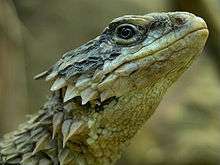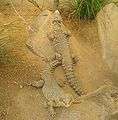Giant girdled lizard
The sungazer (Smaug giganteus, syn. Cordylus giganteus), also known as the giant girdled lizard, giant dragon lizard, or giant zonure,[2] is the largest species of the Cordylidae, a family of lizards from sub-Saharan Africa.[3] This threatened species is endemic to Highveld grasslands in the interior of South Africa.[3] In 2011, it was assigned to the new genus Smaug, along with seven other species previously belonging to the genus Cordylus, based on a comprehensive molecular phylogeny of the Cordylidae.[4]
| Sungazer | |
|---|---|
 | |
| Smaug giganteus | |
| Scientific classification | |
| Kingdom: | Animalia |
| Phylum: | Chordata |
| Class: | Reptilia |
| Order: | Squamata |
| Family: | Cordylidae |
| Genus: | Smaug |
| Species: | S. giganteus |
| Binomial name | |
| Smaug giganteus (Smith, 1844) | |
| Synonyms | |
|
Cordylus giganteus | |
Appearance
The sungazer is a heavily armoured species, with a typical snout–to-vent length of 15–18 cm (5.9–7.1 in) (exceptionally up to 20.5 cm or 8.1 in), and is easily distinguishable from other cordylids by the elongated pair of occipital spines and the enlarged keeled caudal spines.[5]
Names
The species is known as the sungazer because of its distinctive thermoregulatory behaviour of elevating the anterior parts of the body by extending its fore limbs, usually near the entrance of its burrow as if looking at the sun. The species is well known throughout its distribution, and is called by several different common names, in different languages. The most common local name is ouvolk, given by Afrikaans landowners who liken the thermoregulatory basking position of the species to retired farmworkers, who spend much of their days sitting in the sunlight. The sungazer is also known ubiquitously as pPathakalle by Sotho-speaking people and mbedla by Zulu-speaking people.[6]
Behavior
Unlike most other rupicolous (living among rocks) members of the Cordylidae, sungazers live in self-excavated burrows (typically 0.4 m or 1.3 ft deep, and 1.8 m or 6 ft long) in the silty soil of the Themeda grassland in South Africa.[3] They are insectivores, but occasionally eat small vertebrates.[3] These colonial, ovoviviparous lizards reproduce every 2–3 years, and only produce one or two offspring per breeding cycle.[3] They are long-lived, and captives have been recorded surpassing 20 years of age.[3]
Conservation
The decline in sungazer numbers is a result of habitat destruction, and illegal collecting for the pet and traditional medicine trades.[3][7] Entire colonies can disappear when a patch of native grassland is converted to farmland or otherwise "developed".[7]
Sungazers are very difficult to breed in captivity, and successes have only been reported by a few of places worldwide.[8] At least some reports are likely not true captive breeding, but rather pregnant females being caught in the wild and subsequently giving birth in captivity.[8] Wild-caught sungazers are then imported from South Africa to the US, Europe, and Japan, where they command high prices. Most of these animals are smuggled out of the country and are not accompanied by the CITES permits required in legal exports/imports of the species. In its native South Africa, possessing a sungazer (dead or alive) without a permit is illegal.[7] Cordylus tropidosternum and Cordylus jonesii are occasionally marketed as “dwarf sungazers”.
Gallery
- Giant girdled lizard at the San Diego Zoo
- Giant girdled lizard at the San Diego Zoo
 Two giant girdled lizards at the Frankfurt Zoo
Two giant girdled lizards at the Frankfurt Zoo Three giant girdled lizards in Tierpark Hagenbeck
Three giant girdled lizards in Tierpark Hagenbeck- A pair of giant girdled lizards
References
| Wikimedia Commons has media related to Smaug giganteus. |
- World Conservation Monitoring Centre (1996). "Cordylus giganteus". IUCN Red List of Threatened Species. 1996. Retrieved 25 October 2014.CS1 maint: ref=harv (link)
- Mouton, P.le.F.N. 2014. Smaug giganteus (Smith, 1844). Pp 209. In: Bates, M.F., Branch, W.R., Bauer, A.M., Burger, M., Marais, J., Alexander, G.J., De Villiers, M.S. (eds.). Atlas and Red List of the Reptiles of South Africa, Lesotho and Swaziland. Suricata 1. South African National Biodiversity Institute, Pretoria.
- Bill Branch. 1998. Field Guide to Snakes and other reptiles of Southern Africa, p. 189. Struik Publishers, Cape Town. ISBN 1-86872-040-3
- Stanley, Edward L.; Bauer, Aaron M.; Jackman, Todd R.; Branch, William R.; Mouton, P. Le Fras N. (2011). "Between a rock and a hard polytomy: Rapid radiation in the rupicolous girdled lizards (Squamata: Cordylidae)" (PDF). Molecular Phylogenetics and Evolution. 58 (1): 53–70. doi:10.1016/j.ympev.2010.08.024. PMID 20816817.
- Van Wyk, J.H. 1988. Sungazer or Giant Girdled Lizard (Cordylus giganteus). Pp. 78-80. In: W.R. Branch, (ed.) South African Red Data Book – Reptiles and Amphibians. South African National Scientific Programmes Report No. 151.
- Parusnath, 2014. A conservation assessment of the Sungazer (Smaug giganteus). Unpublished Masters thesis. University of the Witwatersrand, South Africa
- Gibbons, B. (2014). Sungazer Lizards are desperately in need of conservation Archived 2016-03-04 at the Wayback Machine. Endangered Wildlife Trust, Threatened Grassland Species Programme. Retrieved 12 November 2014.
- Adams, M. (April 2012). Rare Sungazers pose tough challenge for conservators. National Zoological Gardens of South Africa. Retrieved 12 November 2014.
- Fitzsimons, V. F., 1943. The Lizards of South Africa: Transvaal Museum Memoir, Pretoria.
